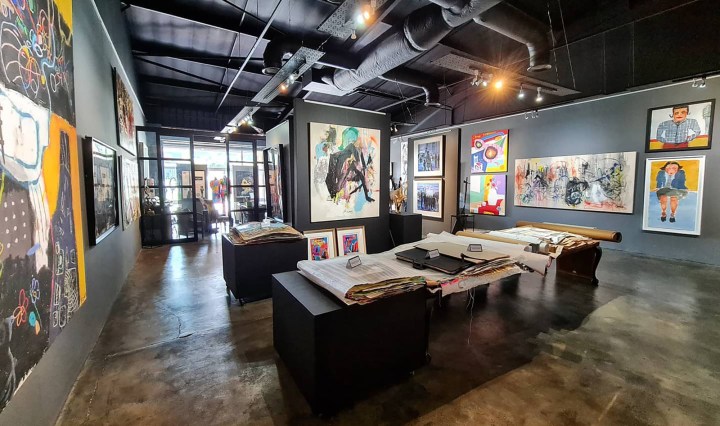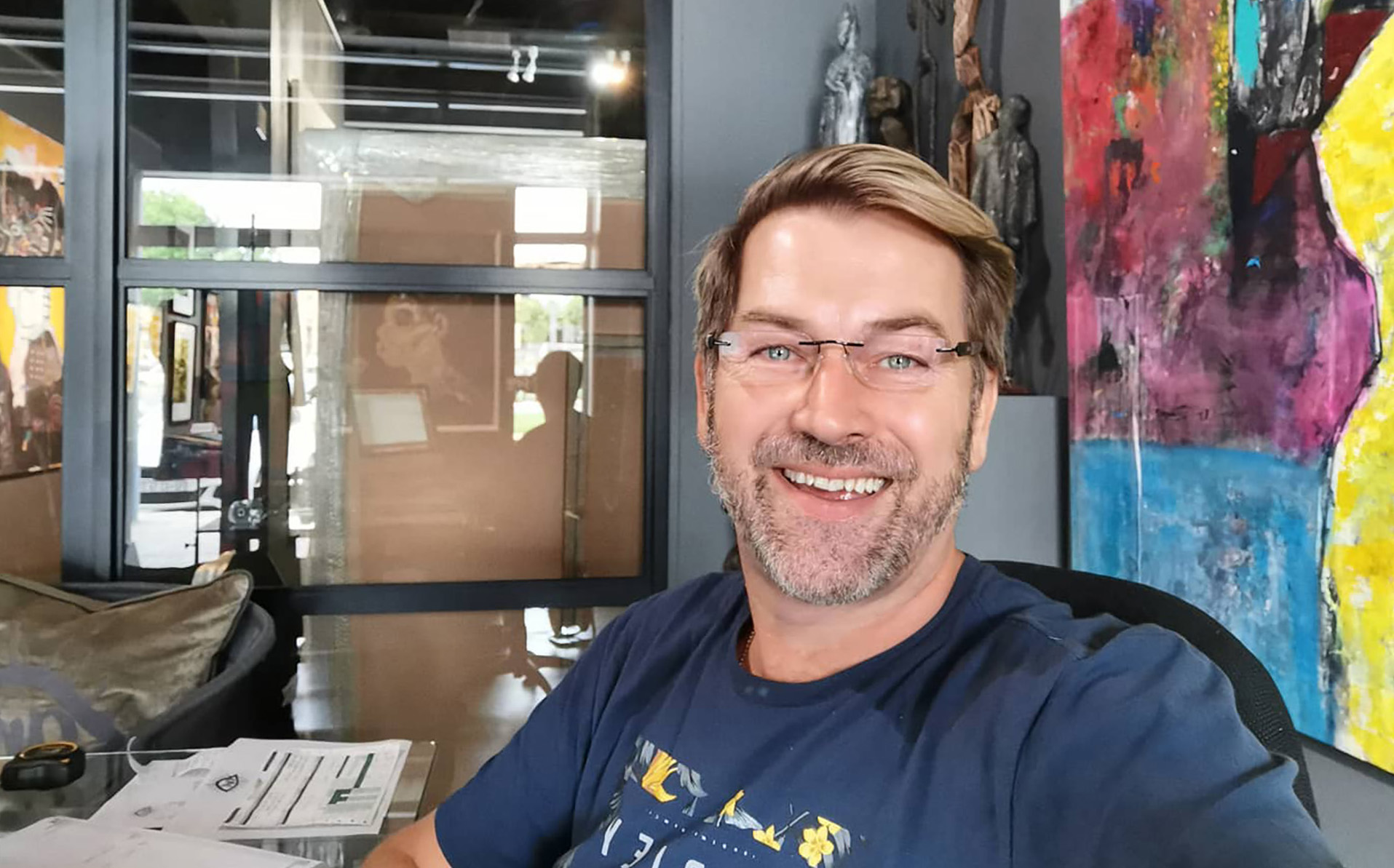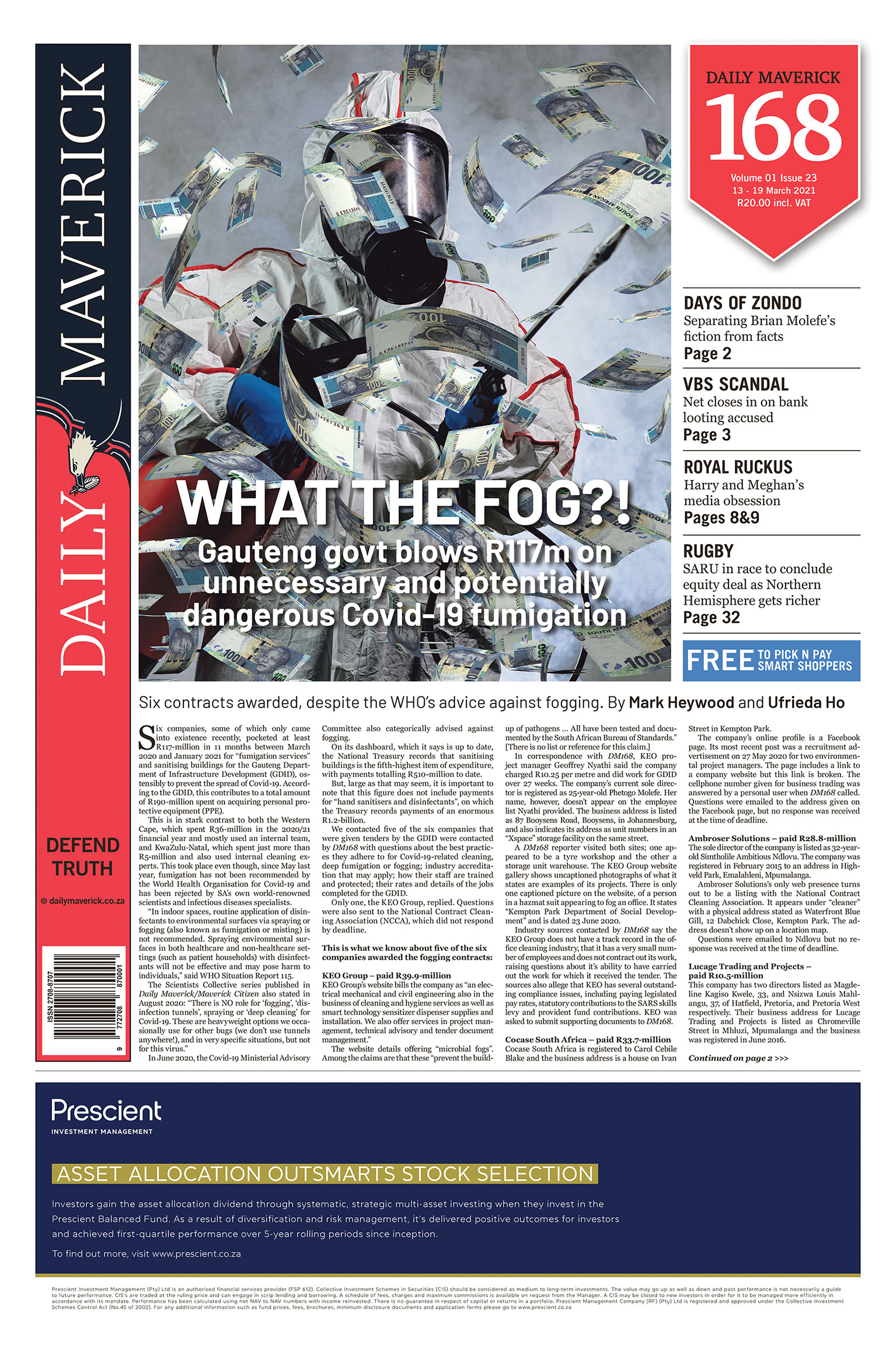BUSINESS MAVERICK 168
Johannesburg Art Heist? The burden of the artist’s proof

A recent outpouring of complaints against a Johannesburg art merchant, alleging everything from unethical business practices to intimidation, extortion and theft, has exposed the inherent risk of exploitation at the heart of South Africa’s contemporary art industry.
First published in the Daily Maverick 168 weekly newspaper.
Tyron Selmon may be the only art merchant in South Africa who’s not in the business of selling art.
“We don’t sell pictures, we don’t sell paintings, we don’t sell sculptures – we market artists,” Selmon told DM168 in a two-hour interview in his office at the Art Eye Gallery in Fourways, Johannesburg. “We put millions of rands behind our artists’ careers.”
Until a flood of allegations appeared on social media sites recently, artists affiliated with Art Eye say it was impossible to know why they weren’t seeing the results of those millions reflected in their bank accounts.
On 2 March, a Facebook post by the London-based South African artist Peter Mammes accused Selmon of extortion. Mammes’s post detailed how, after repeatedly asking the gallery to return unsold works he had consigned to Selmon in 2015, the gallerist emailed him a R40,108 invoice for six years of “monthly art storage”.
Mammes said Selmon had never disclosed that there would be a storage fee. He noted that such costs were generally rolled into galleries’ overheads.
When Mammes told Selmon he was going public with his allegations, the gallerist and his lawyers, Shannon Little Attorneys, sent three letters threatening legal action. Mammes published the post anyway.
“The only agreement I entered into with Tyron was that he sell my art at an agreed upon commission rate. There was no other agreement, verbal or written, with regards to me paying for storage, should the works not sell. I have repeatedly asked for any form of evidence proving otherwise – of which he has yet to produce. Nor has he once asked me to collect my work, but on the contrary, has made it impossible for me to get any of my work back from him.”
No answer
After a year of economic fallout from lockdowns that have ravaged the arts community in particular, the Facebook post resonated.
Over the following days, hundreds of people shared and commented, and other artists alluded to similar experiences. Mammes said he received private messages from dozens of artists alleging serious transgressions by Selmon. Many said they had been trying for years to get dozens or even hundreds of their works returned to them, without success. They are also in the dark about whether or not their works had been sold.
Behind the scenes, Art Eye-affiliated artists who had interacted with Mammes’ post began receiving messages from Selmon, threatening “forensic investigations” and defamation lawsuits.

A screen shot of the Art Eye Gallery Facebook page promoting artist Ben Tuge and his work. Tuge told Daily Maverick the gallery has hundreds of his artworks that he hasn’t earned an income from in years. He currently hawks tomatoes to pay his bills.
DM168 has interviewed 17 artists on Selmon’s roster, past and present, who range in age, level of experience and socioeconomic background. Their testimonies convey a disturbing pattern of coercion, enabled by a gaping loophole at the heart of the industry that has proved all too easy to exploit: an aversion to signing contractual agreements.
“The person who calls the shots is the person who controls the flow of money in the art market,” said Cape Town-based art lawyer Toby Orford.
Artists rely on galleries and auction houses to sell their work, in exchange for a commission – a seemingly straightforward transactional relationship. But, in SA, this dynamic is often based on a tenuous system of mutual trust and verbal agreements.
Artists across a spectrum of experience told DM168 they almost always submit their work to galleries with little more than a handshake, and accept their share of the sale when it transfers into their bank account – usually 40% to 60% after commission. They then collect unsold work when the gallery asks them to do so. In return, galleries absorb the costs of doing business, which include marketing, sales costs and storage.
Africa’s art hub?
The industry in South Africa aspires to be the continent’s art hub, complete with a burgeoning secondary art market, according to Forbes magazine. There has been an influx of young creatives, many of whom have neither the infrastructure to rapidly develop their skills nor the business acumen to question the buyer-seller relationship. They are vulnerable to exploitation, and this is the unregulated lacuna in which Art Eye Gallery appears to have established itself.
During the interview with Selmon, he denied all the allegations against him. “One of the things that we particularly have tried to do is stay out of the hierarchy,” Selmon told DM168. “There’s a very definite plan to what we do, and that structure is different to what other people do,” he said. “I want to make a difference in South Africa [and] create something sustainable within the art business.”
DM168 was unable to obtain any documented overview of the plan or what it meant for artists affiliated with Art Eye. But it appears to have prompted a move in April 2015 to 2,000m2 of rental space at Ellis House, a building catering to artists in Bertrams, Johannesburg.
The lease included several ateliers, and in 2017 Selmon set up a year-long residency for young artists, sponsored by Mercedes-Benz over two years. Every cent went towards the artists, Selmon claimed.
The residency offered access to the studios, materials and a 30% portion of any artworks sold that were created during their tenure, said Selmon. The artists DM168 spoke to said they were promised a monthly stipend to cover their basic costs, and there was talk of group shows and other opportunities.
Months went by, and none of the benefits was forthcoming. According to four sources, the artists were paid piecemeal or not at all, but were charged for their materials – and sales were barely trickling in.

Tyron Selmon, the manager of Art Eye Gallery. The business is registered in his husband Jordan’s name.
Selmon made it clear they were “not allowed to engage with other sellers” or to try to sell or exhibit independently – a demand for exclusivity that came with no contractual assurances. When bills needed to be paid, Selmon would transfer funds to cover them, but payments were never designated to a specific work or formalised in any way.
“All the information was kept secret,” said one artist, who asked to remain anonymous for fear of reprisals. “The (gallery) was keeping everything to themselves because they knew one day you would want to fight them, but you wouldn’t have proof.”
In response to queries about the sponsorship, Mercedes-Benz SA said: “In line with our strategy in 2017/18, MBSA agreed to a two-year sponsorship of the Art Eye Project Room programme, with the focus on the capacitation and advancement of local black emerging artists. To the best of our knowledge the funding was used for the aforementioned purpose. Since then we have provided a further product/marketing sponsorship in exchange for the use of the Art Eye venue for certain events. We have enjoyed a good relationship with Art Eye, and any future sponsorship would depend on our strategy and the circumstances at the time.”
In November 2019, the gallery and its staff disappeared from the building without giving notice or handing over keys, clearing out more than 400m2 of stored artworks, according to Ian Blacher, the sole director of the company that owns Ellis House. A significant rental bill was left unpaid, and is at the centre of an ongoing legal dispute between the building’s owners and Selmon.
Blacher said that, just before he left, and without giving any hint about his plans, Selmon requested that the artists in residence take over the leases for their studios. Some of the artists said they didn’t even know Selmon was planning on leaving the building until they arrived and found the space emptied out. Much of their work went with him, and they have not seen it since.
Protection for artists
Although the lack of formalised business practices creates myriad opportunities for abuse, artists are in some ways well protected by South African law. Freedom of artistic expression, which is enshrined in section 16 of the Constitution, and copyright law provide different kinds of legal protection for artists and their art.
“[The Copyright Act] (including moral rights) is where the law is in fact generous, because it automatically gives artists important rights of control over the use and treatment of their creative output. They don’t have to do anything formal to qualify, but they do need to educate themselves about it and be familiar with its system of rights and obligations,” said Orford.
The onus falls on the artist to dictate and formalise the terms of their engagement with a seller, who will always act in the best interests of their own business.
“There is no uniform code of conduct for art merchants. It is rare for them to explain or negotiate the workings of their relationships,” said Orford. “Most artists lack confidence and leverage. Money is a powerful means of control and it suits art merchants to keep their relationships as unstructured as possible for optimum commercial flexibility,” he said.
As a result, contracts are fundamental in any jurisdiction, said Alexander Horsler, art specialist at Russell Kaplan Auctioneers. “There is no getting away from that,” he said. “A verbal agreement can be binding in South African law, but it may be difficult to enforce the rights arising from such an agreement. So it’s extremely bad form to conduct business in the art world by way of verbal agreement. In fact, it should never happen,” Horsler said.
It is unclear what will happen to the thousands of contested works allegedly still at Art Eye Gallery. Several artists, including the sculptor Carol Hamman, said they took matters into their own hands and retrieved works off the gallery floor, with the help of friends. Hamman said she was confronted by armed guards, but managed to get away with the majority of her work. Selmon said he was planning on “suing her for theft”.
Regarding Mammes’s Facebook post and the conflict over storage fees, Selmon said he didn’t care about getting paid; he was simply trying to teach the young artist a lesson.
“It wasn’t because I thought I was going to get the money,” Selmon said. “It was because I wanted him to take responsibility, after [all these] years.”
How you can protect yourself as an artist
Art dealers are the major point of contact between artists and collectors, critics and institutions, says Orford. So their role in your career is critical, and your relationships with art dealers need to be carefully and professionally managed.
Start with defining your relationship in a contract. Whether you are consigning your work to a gallery or an auction house, or signing up with an agent or representative to promote you, insist that all the terms of the engagement are written into a formal contract agreement and signed by you and the other party. Read the contract carefully before signing and ask for clarification on anything that you don’t understand.
Contracts are flexible, because either party can ask to change the terms at any stage. But they also offer protection, because both parties need to agree to those changes, says Orford. You may never need to consult your contract again once it’s signed but, if your relationship with a dealer breaks down, you’ll be glad to have everything in writing to navigate whatever happens next.
Don’t accept verbal agreements. “This can be a pitfall for an artist who does not understand the importance of getting things in writing, or who may be gullible enough to trust in the ‘good intentions’ of the other party,” says Horsler. If a seller refuses to go through the process of drawing up a contract with you before you hand over your art, you should consider walking away from the deal and finding a representative willing to interact with integrity and transparency.
Once the relationship is formalised on terms you’re happy with, keep a careful and detailed written record of all the artworks that are leaving your studio, even if the seller is doing the same thing. That way, you can compare notes if necessary, or question differences in records. “As the agent it is my responsibility to provide an inventory of the items I have to sell on behalf of the seller; to explicitly state what my commission will be and to explicitly state what price the artwork will be marketed at,” says Horsler.
Make sure you get a receipt, consignment slip or some other proof of transaction for every artwork you let go of. Take a picture of it and save it in an organised folder so that you can refer to it later if you need to. DM168
This story first appeared in our weekly Daily Maverick 168 newspaper which is available for free to Pick n Pay Smart Shoppers at these Pick n Pay stores.


















 Become an Insider
Become an Insider
When I was a young artist I thought the crooked galleries and scamsters targeted the inexperienced like me. Then I met old pros who could entertain for a week with similar tales of galleries to dodge.